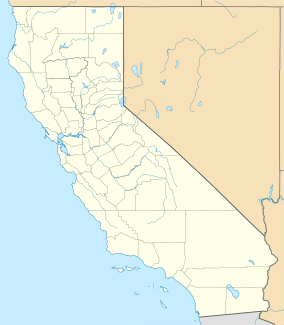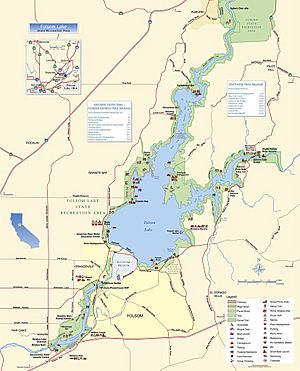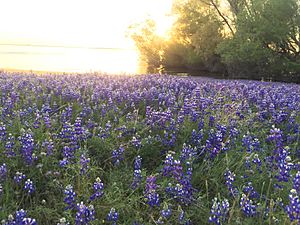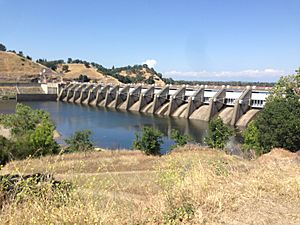Folsom Lake State Recreation Area facts for kids
Quick facts for kids Folsom Lake State Recreation Area |
|
|---|---|
| Location | El Dorado, Placer, and Sacramento Counties, California, USA |
| Nearest city | Folsom, California |
| Area | 19,564 acres (79.17 km2) |
| Established | 1956 |
| Governing body | California Department of Parks and Recreation |
The Folsom Lake State Recreation Area is a fun outdoor spot in California. It surrounds Folsom Lake in the hills of the Sierra Nevada mountains. The California Department of Parks and Recreation takes care of this area. It is located near the city of Folsom, California, about 25 miles (40 km) east of Sacramento.
Contents
Discover Folsom Lake State Recreation Area
This large park covers about 19,564 acres (7,917 ha). It was created in 1956 after the Folsom Dam was built. Folsom Lake is one of California's biggest reservoirs. It's a very popular place for outdoor activities in the Sacramento area. The park includes two lakes: Folsom Lake and Lake Natoma. Around 2 million people visit the Folsom Lake State Recreation Area each year. Summers here are usually hot, and winters are mild.
The lake and recreation area offer many cool things to do. You can go hiking, biking, running, or camping. It's also great for picnics and horseback riding. If you love water sports, you can enjoy water-skiing and boating. Fishing is popular too, with trout, catfish, largemouth and smallmouth bass, or yellow perch to catch.
You can also visit the nearby Folsom Powerhouse State Historic Park. This historic site once made a lot of electricity for Sacramento. It was called "the greatest operative electrical plant on the American continent." For bike riders, there's a 32-mile (51 km) long bike path. It connects Folsom Lake to many Sacramento County parks. The path even reaches Old Sacramento. The park also has Lake Natoma, which is just below Folsom Lake. This lake is perfect for crew races, sailing, kayaking, and other water sports.
The best time to visit is in spring and summer. Temperatures are often in the 80s, 90s, and even 100s Fahrenheit. Most visitors come from April through September. In spring, evenings and weekends are the busiest times on the lake. The Folsom Lake State Recreation Area has 95 miles (153 km) of trails. Hikers, bicyclists, runners, and horseback riders use these trails. Part of the Western States/Pioneer Express Trail also goes through the park. This trail runs between Sacramento and Carson City, Nevada. A paved bike trail goes around Lake Natoma. It connects to Beals Point and the American River Bike Trail.
A Look Back: History of the Area
Native American Heritage
For thousands of years, Native Americans lived around Folsom Lake. These were mainly the Maidu or Nisenan tribes. In winter, they stayed in villages near the American River. In summer, they built temporary homes from bark. The Nisenan used local plants like acorns and berries. They traded these with tribes living near the coast. They were skilled at weaving baskets from willow, redbud, and other plants.
In 1848, the California Gold Rush began. Sadly, much of the Nisenan land was taken away. Many Nisenan people became sick from new diseases. Their population dropped a lot. However, some survived and still live on reservations nearby.
Gold Rush Days
The Folsom Lake area was a very important mining spot during the California Gold Rush of 1849. During recent dry years, water levels in Folsom Lake dropped very low. This revealed the old mining town of Mormon Island. Mormon Island was a sandbar where gold was first found by members of the Mormon Battalion.
When news of the gold spread, Mormon Island grew quickly. By 1853, it had up to 2,500 people. But by the 1940s, only a few families were left. Fires, less gold, and a new railroad caused people to leave. People from all over the world came to mine for gold. They came from England, China, Hawaii, and many U.S. states. They camped near their mining spots. These camps eventually became small towns. Some of these towns were Rattlesnake Bar, Mormon Bar, and Oregon Bar.
Building the Dams
The Natoma Water Company started in 1851. Local miners formed it to build a 20-mile (32 km) ditch. This ditch would bring water to miners looking for gold. It was called the "Natoma Ditch" and cost about $175,000 to build. In 1953, the government bought most of the land. They wanted to build Folsom Lake. The Natoma Water Company is now called Natoma Company.
Folsom Dam was built in 1955. It's a concrete dam with earth walls. The total length is about nine miles (14 km). The lake's shoreline stretches about 15 miles (24 km) up the American River. Lake levels at Folsom Lake usually change throughout the year. They are highest in spring and lower in summer. Downstream, behind Nimbus Dam, is smaller Lake Natoma. Folsom and Nimbus Dams were built to control the American River. They also help with flood protection, water supply for homes, power, and irrigation.
In 1979, a plan for the Folsom Lake State Recreation Area was approved. Many people helped create this plan. They wanted Lake Natoma to stay quiet. But they agreed Folsom Lake needed updates for more fun activities.
Plants and Animals of Folsom Lake
The Folsom Lake State Recreation Area is home to many different plants and animals. Common trees include blue oaks and interior live oaks. You can also see foothill pines and annual grasses. In spring, the area bursts with wildflowers. These include Indian paintbrush, larkspur, lupine, and fiddleneck.
Many animals live here too. You might spot black-tailed deer, raccoons, skunks, and opossums. Gray foxes and coyotes also live in the park. Birds are everywhere! You can see nesting egrets, herons, and cormorants. Canada geese, blackbirds, scrub jays, and quail are common. Near the water, look for kingfishers and grebes. Red-tailed hawks, American kestrels, ospreys, and eagles fly overhead. Be aware that Rattlesnakes are also common here.
The park has very old blue oak trees, some are 400–500 years old. About half of the plants are interior live oaks. Another quarter are blue oaks. The rest are grasslands, wetlands, and other plant types.
Birdwatching is a great activity all year. Many birds migrate through in autumn and spring. Lake Natoma and Folsom Lake host up to 80,000 gulls in winter. Great blue herons and great egrets start nesting in February. Their young can be seen from March through August.
Campgrounds for Your Adventure
Peninsula Campground
Peninsula campground is located on a piece of land between the North and South Forks of the American River. You can get there by driving 11 miles (18 km) on Rattlesnake Bar Road. You can also reach it by boat for boat-in camping. It has 100 campsites with restrooms, hot showers, and water. There are also two boat launch ramps. This campground is a bit remote. It might close in winter or if roads are bad. You can reserve campsites during the busy season. During the off-season, it's first-come, first-served.
Beals Point Campground
Beals Point is on the west side of Folsom Lake, just north of the dam. You can get there from Auburn-Folsom Road. It has 69 sites for trailers and RVs up to 31 feet (9.4 m) long. Facilities include restrooms, hot showers, and water. There's also a snack bar and a beach where you can rent equipment.
Negro Bar Group Campsites
Negro Bar is on the west side of Lake Natoma. You can find it off Greenback Lane in Folsom. This campground has three group sites. Sites A and B can hold 50 people each. Site C can hold 25 people. Restrooms are available. A group must have at least nine people to use these sites.
Gold was first found along the American River at a place called Negro Bar. This spot got its name because it was one of the first places where African-American gold miners worked during the California Gold Rush. Negro Bar was a large sandbar in what is now Folsom. Most African American miners left by 1852 for more successful mining areas. Today, Negro Bar State Recreation Area is across the American River.
Avery's Pond Environmental Campsites
Avery's Pond is near Rattlesnake Bar. It's north of the Rattlesnake Bar Equestrian Assembly Area. You park at Rattlesnake Bar and walk 1.1 miles (1.8 km) to the sites. There are two sites, and each holds eight people. There is no water or trash service here. Dogs and fires are not allowed. It's often used as a horseback riding trail.
Avery's Pond is a historic pond built in the 1880s by a rancher named Ira Avery. It's about 20 feet (6.1 m) above Folsom Lake. Water from the 1854 North Fork Diversion ditch filled Avery's Pond. This gave Avery's large orchards a steady water source all year. Avery used to provide lumber, fruit, and sheep to the gold miners. His ranch had about 117 acres (47 ha). About 40 acres (16 ha) had 1,500 fruit trees, including pears, persimmons, and cherries.
Nimbus Dam and Lake Natoma
Nimbus Dam and Lake Natoma are also part of the Folsom Lake State Recreation Area.
The American River used to have about 100 miles (160 km) of stream where salmon and steelhead fish could lay eggs. When the Folsom-Nimbus project was finished in 1958, most of these areas were blocked. So, the Nimbus Hatchery was built. It helps replace the salmon and steelhead runs that were blocked by Nimbus Dam. The Nimbus Fish Hatchery raises Chinook salmon and steelhead. They release about 4 million Chinook salmon and 43,000 steelhead each year into the American River. The hatchery also offers educational activities for kids and adults.
Lake Natoma is a smaller lake on the American River. It sits between Folsom Dam and Nimbus Dam. It's mainly used for recreation. The Negro Bar State Recreation Area is part of it. The Sacramento State Aquatic Center is also located here. You can rent equipment for paddling, rowing, water skiing, and sailing. The Aquatic Center is a team effort between Sacramento State students, the University Union, and California state departments.






